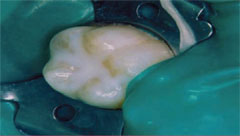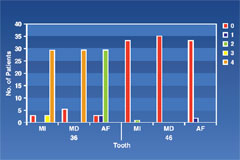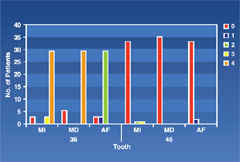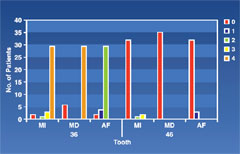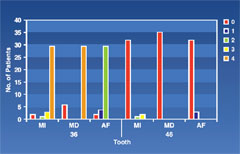Departments
Research
Jan 2008 —
Vol. 2,
Iss. 1
Retention of Pit-and-Fissure Sealants With and Without A Seventh Generation Bonding Agent: A Clinical Study
Usha Mohan Das, MDS; Deepak Vishwanath, MDS; Ragnathan Venkatasubramanian, BDS; and Suma Gopal, BDS
Usha Mohan Das, MDS; Deepak Vishwanath, MDS; Ragnathan
Venkatasubramanian, BDS;
and Suma Gopal, BDS
Abstract
Objective: The objective of this study was to assess the effect of a
seventh generation bonding agent on sealant retention after 3, 6, 9, and 12
months. Method and Materials: The sample group consisted of 35 school children (ages 7 to 9)
with sound, caries-free permanent mandibular
molars. Occlusal sealants were placed on the first mandibular molars using
the split-mouth design. Pit-and-fissure sealants (Fissurit F, VOCO, Sunnyside, NY) were placed with and without the
bonding agent (iBond®, Heraeus-Kulzer, Armonk, NY). The results were evaluated at 3-, 6-, 9-, and
12-month intervals. The data obtained were analyzed using T-test and ANOVA
statistical methods. Results: Results of statistical analysis showed that P < .05 in all
cases. Conclusion:
The study demonstrated that the use of a bonding agent prior to the application of pit-and-fissure sealant does not
increase retention rate.
INTRODUCTION
The placement of sealants and their continued
maintenance are
scientifically sound and cost effective techniques for preventing pit-and-fissure caries in children. The preventive
function of a pit-and-fissure sealant is achieved by the adherence of the
material to the acid-etched enamel surface, thus physically occluding the pits and fissures from the rest of the oral
environment. As long as the sealant remains
intact, caries should not develop beneath it.1 Thus, retention
rates are of interest, as a sealant’s
effectiveness is directly related to its retention, and completely sealed fissures should not develop caries.
Recent studies have shown improved results when an
intermediate bonding layer is applied between enamel and sealant after
etched enamel comes into contact with saliva: the use of a bonding agent
under sealants on contaminated enamel increases bond strength, reduces
microleakage, and enhances the flow of resins into fissures.2-6
A recently introduced seventh generation bonding
agent, iBond, performs etching, disinfecting,
priming, and bonding in a single step. The benefits of this
procedure are that it increases patient
comfort, reduces chairside time, decreases contamination, and increases
efficacy—which would be promising in preventing pit-and-fissure
caries in pediatric patients.
This article reports data from a clinical study of
sealant retention with and without bonding
agents.
METHOD AND MATERIALS
The sample group consisted of 35 school children (ages
7 to 9), who had sound and unsealed permanent first mandibular molars, and who reported to the Department of Pedodontics and
Preventive Dentistry, Vokkaligara Sangha Dental College and
Hospital, Bangalore, India. Informed consent was obtained from the
parents of all participants.
Occlusal sealants were placed on first mandibulars
using a split-mouth
design. The mandibular right first molar (tooth No. 46) was treated with a
conventional method of acid-etching and sealed. The mandibular left first molar (tooth No. 36) was
treated with bonding agent and sealed.
Application procedures followed accepted protocols.
Caries-detecting dye was applied and rinsed off
after 5 seconds. The tooth was polished using a
slow-speed dry brush and isolated using a rubber dam. On tooth No. 46, 37% phosphoric acid gel was applied for 15 seconds, rinsed
for 12 to 20 seconds, and dried. Pit-and-fissure sealant (Fissurit F) was
applied and cured (Figure 1A View Figure). On tooth
No. 36, iBond was applied and cured and then Fissurit F was applied and
cured (Figure 1B View Figure).
Scoring
Criteria for sealant scoring are listed in Table 1.
Data obtained were analyzed by employing
T-test and ANOVA statistical methods.
RESULTS
Patients were evaluated for retention of
pit-and-fissure sealant at 3-, 6-, 9-, and 12-month intervals in relation to marginal integrity (MI), marginal discoloration (MD), and anatomic
form (AF) for teeth Nos. 36 and 46. Figure 2 (View Figure);
Figure 3 (View Figure); Figure 4 (View Figure); Figure 5 (View Figure) provide a graphical
representation of the results.
For tooth No. 36 (sealant without bonding agent), the
MI rates were 94% at 3 and 6 months, and 91% at
9 and 12 months. The
MD rates were 100% at all four intervals. The AF of the sealants was 94% at 3 and 6 months, and 91% at 9 and 12 months.
The clinically acceptable MI rates for tooth No. 46
(sealants with a bonding agent) were 83% at the
end of 3, 6, 9, and 12 months. The rates for no color change in sealants with a bonding agent after 3 months were 83%. The AF of the sealants
after the teeth sealed with a bonding agent at 3
months was 83%; subsequently after 6, 9, and 12 months the AF
reported percentage was 83%. The results of the
study are similar to the results obtained by Pinar et al.7
The authors observed that these results were
statistically significant (P < .05) in all cases. Also, the scores of each individual for MI/MD/AF for different time periods were analyzed using ANOVA, and these results also revealed a significance value (P < .05), by which the authors
conclude that the seal on tooth No. 46 is
better than that on No. 36.
DISCUSSION
Pit-and-fissure sealants have become the most
effective noninvasive treatment to prevent or
arrest occlusal caries. The occlusal surface is
at high risk for caries. This is especially true for newly erupted molars, where anatomic characteristics cause
difficult access for cleaning procedures and incomplete maturation of enamel adds to caries susceptibility.8,9 iBond contains UDMA, 4-META in an acetone/water solvent, and Gluma® (Heraeus-Kulzer) desensitizer. The 4-META monomer is responsible for conditioning due to its acid function. UDMA is used as a cross-linking and film-forming monomer to add the required
stability to the adhesive layer. As the acid component is neutralized during the etching process, demineralization is automatically
limited and stopped after a short time. Acetone
and water, used as solvents, ensure deep penetration of the monomers.
The present trend of using self-etching adhesives
seems overstated in terms of its enormous
benefit if applied to pit-and-fissure sealants. Literature shows conflicting findings concerning
the need of a bonding agent prior to
application of pit-and-fissure sealants.1 Based on the results
observed in this study, the use of a seventh
generation bonding agent was not significantly effective in the retention of pit-and-fissure sealants, when compared to the conventional
phosphoric acid-etching technique.
ACKNOWLEDGMENT
The authors would like to thank the staff and
P.G.’s at the Department of Pedodontics and Preventive Dentistry.
REFERENCES
1. Ripa LW. The current status of pit and fissure sealants: a
review. J Can Dent Assoc. 1985;51(5):367-380.
2. Hitt JC, Feigal RJ. Use of a bonding agent to
reduce sealant sensitivity to moisture contamination: an in vitro study. Pediatr
Dent. 1992;14(1):41-46.
3. Dukic W, Glavina D. Clinical evaluation of three
fissure sealants: 24 month follow-up. Eur Arch Paediatr Dent. 2007;8(3):
163-170.
4. Burbridge L, Nugent Z,
Deery C. A randomized controlled trial of the effectiveness of a one-step
conditioning agent in fissure sealant placement: 12 month results. Eur Arch
Paediatr Dent. 2007;8(1):49-54.
5. Burbridge L, Nugent Z,
Deery C. A randomized controlled trial of the effectiveness of a one-step
conditioning agent in fissure sealant placement: 6-month results. Int J
Paediatr Dent. 2006;16(6):424-430.
6. Borem LM., Feigal RJ. Reducing microleakage of
sealants under salivary contamination: digital
image analysis evaluation. Quintessence Int. 1994;25(4):283-289.
7. Pinar A, Sepet E, Aren G, Bölükbas¸i N, Ulukapi H, Turan N. Clinical performance of sealants with and
without bonding agent. Quintessence Int. 2005;36(5):355-360.
8. Feigal RJ, Musherure
P, Gillespie B, Levy-Polack M, Quelhas I,
Hebling J. Improved sealant retention with bonding agents: a clinical study of two-bottle and single-bottle systems. J Dent Res. 2000;79(11):1850-1856.
9. Hebling J, Feigal RJ. Use of one-bottle adhesive
as an intermediate bonding layer to reduce sealant microleakage on
saliva-contaminated enamel. Am J Dent. 2000;13(4):187-191.
|
|
|
| Figure 1A Mandibular right first permanent molar with pit-and-fissure sealant placed. |
|
Figure 1B Mandibular left first permanent molar with pit-and-fissure sealant placed with iBond. |
|
|
|
| Figure 2 Results at 3 months.
*36 and 46: Permanent left and right first mandibular molar. *Scores: 0,1,2,3,4 |
|
Figure 3 Results at 6 months.
*36 and 46: Permanent left and right first mandibular molar. *Scores: 0,1,2,3,4 |
|
|
|
| Figure 4 Results at 9 months.
*36 and 46: Permanent left and right first mandibular molar. *Scores: 0,1,2,3,4 |
|
Figure 5 Results at 12 months.
*36 and 46: Permanent left and right first mandibular molar. *Scores: 0,1,2,3,4 |





